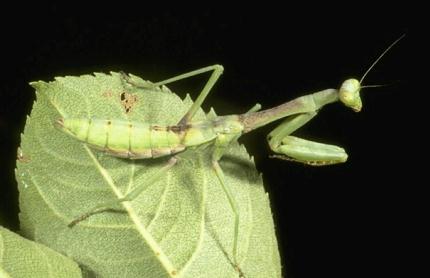Common name: Praying mantids (plural)
Mantodea:Mantidae
Some important mantids species
- African mantis (Sphodromantis spp.) found in Africa
- Chinese mantis (Tenodera aridifolia sinensis) found in China
- Devils flower mantis (Blepharoppsis mendica) found in Asia
- Giant Malaysian shield mantis (Rhombodera basalis) found in Malaysia
- Giant mantis (Hierodula spp.) found in Asia
- Ghost mantis (
Phyllocrania Paradoxa) found in Africa and Madagascar
- Indian flower mantis (Creoboter meleagris) found in India
- Leaf mantis (Deroplatys spp.) found in Asia
- Madagascan marbled mantis (Polyspillota aeruginosa) found in West Africa and Madagascar, Nigeria and Kenya
- Malaysian orchid mantis (Hymenopus coronatus) found in Indonesia, Malaysia, and Sumatra
- Spiny flower mantis (Pseudocreobotra spp.) found in Africa
- Twig mantis (Popa spurce) found in Africa
- Wondering violin mantis (Gongylus gongylodes) found in India and Sri Lanka
Type
Predator
Hosts
Aphids, fruit flies, grasshoppers, caterpillars, and they eat each other when no food is available.
Description
The eggs are laid in groups. Each group of eggs is encased in a foamy substance that hardens into a tough protective casing called
ootheca. Eggs hatch after 3 - 8 weeks, although not all eggs will hatch as young mantids.
The young mantids are hatched as pro-nymphs. They are surrounded by a protective membrane and move like grubs to the surface of the ootheca. In some species, there is a single exit hole at the bottom of the ootheca, where the young emerge individually. In others, the young emerge through the oothecal wall nearest the egg cell and will hang on silken cord from the ootheca until the skin hardens.
The adult praying mantis varies in color depending on the habitat it is living in. It camouflages the leaves, flowers, twigs, barks, trees where it is found. Its size varies depending on the species, from about 3 cm-18cm. It has strong spine-forelegs and usually sits and waits motionless among vegetation for prey, with its forelegs held together in a prayerful manner, hence the name 'Praying mantis'. It has strong mouthparts for chewing, large eyes, well-set on its mobile triangular head, with
antennae that are slender and segmented. It has a neck that can rotate its head while waiting for prey.
Some species have powerful forewings for protection and flying. While flying, it can be mistaken as for a small bird. Other species are wingless, odd-looking, flower/leaf-shaped, and others are so thin to be recognizedthat they are hardly recognizable. They will rise up in a threatening manners ready to attack, when disturbed.
A female adult should be well fed prior to mating or else she will kill the male once she is hungry after mating. A female mantis lays up to a few hundred frothy liquid eggs in habitats where mantids live.
Conservation
Avoid indiscriminate use of pesticides, for pesticides kill and reduce the numbers of praying mantids and other beneficial insects. Maintain vegetation to provide natural habitats for the mantids.
External links
References
- Lyon, W. (1991): Praying Mantis. Ohio State University Extension Fact Sheet
Peer-reviewed

